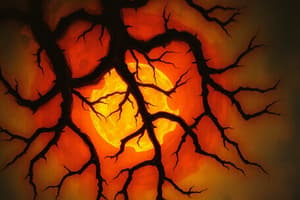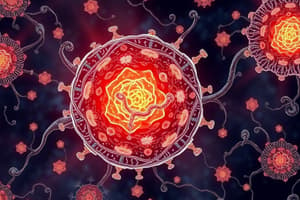Podcast
Questions and Answers
What are the causes of cell injury?
What are the causes of cell injury?
The causes of cell injury would be:-
- Oxygen deprivation
- Physical damage (trauma)
- Microbial
- Immunological
- Chemical
What are the ways in which a cell can be damaged?
What are the ways in which a cell can be damaged?
There are six categories by which damage to cells can be characterised:-
- ATP depletion/reduced synthesis
- Mitochondrial damage
- Intracellular calcium
- Free radical damage
- Defective membrane permeability
- Protein misfolding
What is hypoxia?
What is hypoxia?
Hypoxia is the low oxygen circulation in the body tissues. This leads to an interference with the aerobic oxidative respiration.
What causes hypoxia?
What causes hypoxia?
What is the result of a hypoxic injury?
What is the result of a hypoxic injury?
What are results of a persistent hypoxia condition?
What are results of a persistent hypoxia condition?
What is the ischaemia reperfusion injury?
What is the ischaemia reperfusion injury?
What is free radical?
What is free radical?
What is a reactive oxygen species?
What is a reactive oxygen species?
What is the result of high ROS levels?
What is the result of high ROS levels?
What are some ways of mechanical injury for cells?
What are some ways of mechanical injury for cells?
How can microbial injury damage cells?
How can microbial injury damage cells?
How can chemicals damage cells?
How can chemicals damage cells?
How can cells respond to injury?
How can cells respond to injury?
What are the mechanisms in which a cell can respond to stress?
What are the mechanisms in which a cell can respond to stress?
What is atrophy?
What is atrophy?
What is hypertrophy?
What is hypertrophy?
What is hyperplasia?
What is hyperplasia?
What is metaplasia?
What is metaplasia?
What are the two forms of cell death following irreversible cell damage?
What are the two forms of cell death following irreversible cell damage?
What is the difference between apoptosis and necrosis?
What is the difference between apoptosis and necrosis?
What are the types of necrosis?
What are the types of necrosis?
What is coagulative necrosis and what causes it?
What is coagulative necrosis and what causes it?
What is caseous necrosis?
What is caseous necrosis?
What is colliquative necrosis?
What is colliquative necrosis?
What is fat necrosis?
What is fat necrosis?
What is gangrenous necrosis?
What is gangrenous necrosis?
What are the types of gangrenous necrosis?
What are the types of gangrenous necrosis?
What is autolysis?
What is autolysis?
What is necrosis?
What is necrosis?
What is apoptosis?
What is apoptosis?
What is the physiological importance of apoptosis in embryogenesis?
What is the physiological importance of apoptosis in embryogenesis?
What is the physiological importance of apoptosis in the menstrual cycle?
What is the physiological importance of apoptosis in the menstrual cycle?
What is the physiological importance of apoptosis in the immune system?
What is the physiological importance of apoptosis in the immune system?
What is the clinical diagnosis of cell death?
What is the clinical diagnosis of cell death?
What are the ways of healing and repair?
What are the ways of healing and repair?
What are the factors in regeneration of cells?
What are the factors in regeneration of cells?
How can we classify cells in terms of their capacity of regeneration? Also provide examples.
How can we classify cells in terms of their capacity of regeneration? Also provide examples.
Flashcards are hidden until you start studying



